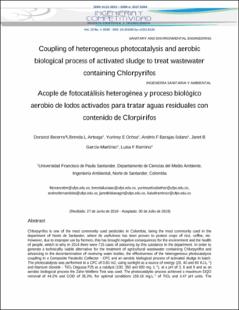Coupling of heterogeneous photocatalysis and aerobic biological process of activated sludge to treat wastewater containing Chlorpyrifos
...
Becerra Moreno, Dorance | 2020-01-03
Chlorpyrifos is one of the most commonly used pesticides in Colombia, being the most commonly used in the department of Norte de Santander, where its usefulness has been proven to protect crops of rice, coffee, etc. However, due to improper use by farmers, this has brought negative consequences for the environment and the health of people, which is why in 2014 there were 715 cases of poisoning by this substance in the department. In order to generate a technically viable alternative for the treatment of agricultural wastewater containing Chlorpyrifos and advancing in the decontamination of receiving water bodies, the effectiveness of the heterogeneous photocatalysis coupling in a Composite Parabolic Collector - CPC and an aerobic biological process of activated sludge in batch. The photocatalysis was performed in a CPC of 0.83 m2, using sunlight as a source of energy (20, 40 and 60 KJ.L-1 ) and titanium dioxide - TiO2 Degussa P25 as a catalyst (100, 350 and 600 mg. L-1 ), at a pH of 3, 6 and 9 and as an aerobic biological process the Zahn-Wellens Test was used. The photocatalytic process achieved a maximum DQO removal of 44.2% and COD of 35.3%, for optimal conditions 159.19 mg.L-1 of TiO2 and 3.47 pH units. The biological process managed to degrade 17.0% of DQO and 9.3% of COD for wastewater without pretreatment. After pretreatment by photocatalysis, the removal of the biological process increased to 88.2% DQO and 67.8% COD. From the results obtained, it is established that the coupling of heterogeneous photocatalysis and an aerobic biological process is a viable alternative for the treatment of agricultural wastewater with the presence of Chlorpyrifos.
LEER










